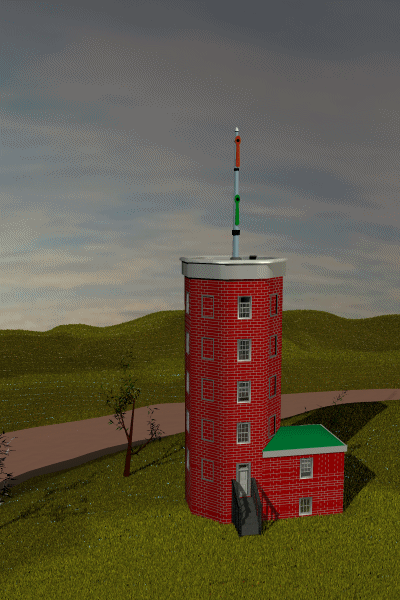Wednesday, October 23, 2019
Chatley semaphore
I think this is the last one in the set. I've now included all the types of semaphore that were actually used. Next I'll start buttoning up the set for release.
England was slow to follow Chappe's lead, partly because of Not Invented Here and partly because of plain old fog. Visual semaphores were usable less than half the time in England, while the massive Chappe system in France had the advantage of a more continental climate and lower latitude.
I've already illustrated the first English system, with six flaps or shutters that flipped up and down. Chatley used the more common two-flag setup, based on the older all-human systems with two actual flags or just two arms.
 The two signal arms have 8 positions each, theoretically capable of 8 * 8 = 64 combinations, but the Navy seems to have used only a subset for UC and numbers. The short lower flag served two purposes. (1) It was an alarm to warn the watchers that a message was coming soon, so the watchers didn't have to be constantly alert. (2) It always flopped out to the right, so a watcher from either side could tell which way to read the signals.
Chatley is the only semaphore building in England that remained intact through two centuries of disuse. This webpage by Landmark Trust was written for a crowdfunding effort to restore Chatley, and includes most of the history. The crowdfunding appears to have reached its goal, and restoration has started.
The semaphore chain served the Navy from 1822 to 1842, when electric telegraphs replaced it. Fog is the mother of invention.
= = = = =
Links to the illustrations so far:
Russian 1850s
Chappe clock system and wing system
Dupillon (French) [I snuck this into an older item without properly describing it]
Six shutter (English)
More discussion of Chappe
Chatley (English)
= = = = =
And finally, here's the finished set at ShareCG.
The two signal arms have 8 positions each, theoretically capable of 8 * 8 = 64 combinations, but the Navy seems to have used only a subset for UC and numbers. The short lower flag served two purposes. (1) It was an alarm to warn the watchers that a message was coming soon, so the watchers didn't have to be constantly alert. (2) It always flopped out to the right, so a watcher from either side could tell which way to read the signals.
Chatley is the only semaphore building in England that remained intact through two centuries of disuse. This webpage by Landmark Trust was written for a crowdfunding effort to restore Chatley, and includes most of the history. The crowdfunding appears to have reached its goal, and restoration has started.
The semaphore chain served the Navy from 1822 to 1842, when electric telegraphs replaced it. Fog is the mother of invention.
= = = = =
Links to the illustrations so far:
Russian 1850s
Chappe clock system and wing system
Dupillon (French) [I snuck this into an older item without properly describing it]
Six shutter (English)
More discussion of Chappe
Chatley (English)
= = = = =
And finally, here's the finished set at ShareCG.
 The two signal arms have 8 positions each, theoretically capable of 8 * 8 = 64 combinations, but the Navy seems to have used only a subset for UC and numbers. The short lower flag served two purposes. (1) It was an alarm to warn the watchers that a message was coming soon, so the watchers didn't have to be constantly alert. (2) It always flopped out to the right, so a watcher from either side could tell which way to read the signals.
Chatley is the only semaphore building in England that remained intact through two centuries of disuse. This webpage by Landmark Trust was written for a crowdfunding effort to restore Chatley, and includes most of the history. The crowdfunding appears to have reached its goal, and restoration has started.
The semaphore chain served the Navy from 1822 to 1842, when electric telegraphs replaced it. Fog is the mother of invention.
= = = = =
Links to the illustrations so far:
Russian 1850s
Chappe clock system and wing system
Dupillon (French) [I snuck this into an older item without properly describing it]
Six shutter (English)
More discussion of Chappe
Chatley (English)
= = = = =
And finally, here's the finished set at ShareCG.
The two signal arms have 8 positions each, theoretically capable of 8 * 8 = 64 combinations, but the Navy seems to have used only a subset for UC and numbers. The short lower flag served two purposes. (1) It was an alarm to warn the watchers that a message was coming soon, so the watchers didn't have to be constantly alert. (2) It always flopped out to the right, so a watcher from either side could tell which way to read the signals.
Chatley is the only semaphore building in England that remained intact through two centuries of disuse. This webpage by Landmark Trust was written for a crowdfunding effort to restore Chatley, and includes most of the history. The crowdfunding appears to have reached its goal, and restoration has started.
The semaphore chain served the Navy from 1822 to 1842, when electric telegraphs replaced it. Fog is the mother of invention.
= = = = =
Links to the illustrations so far:
Russian 1850s
Chappe clock system and wing system
Dupillon (French) [I snuck this into an older item without properly describing it]
Six shutter (English)
More discussion of Chappe
Chatley (English)
= = = = =
And finally, here's the finished set at ShareCG.
Labels: Morsenet of Things
